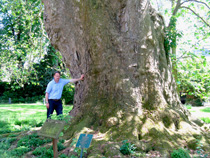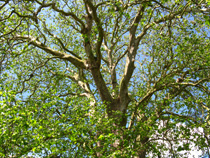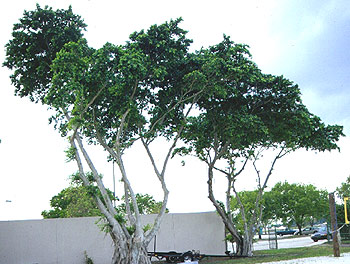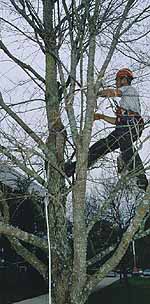Home > Pruning shade trees > Mature trees
Mature trees: managing risk
Prune in leu of removal 
Philosophy
Support systems
Pruning examples: Set 1, Set 2, Set 3
Scenarios: Set 1, Set 2
Fact sheet: Pruning mature trees (14 pgs, pdf)
See: Recent research confirms pruning reduces damage
Pruning large and mature trees focuses primarily on ensuring human safety and passage, minimizing limb failure or total-tree failure near targets such as buildings and cars, and maintaining tree health and vigor. This means 1) minimizing hazardous conditions by reducing foliage mass and weight especially toward the ends of the largest and longest branches and those with defects (See: tree defects), 2) canopy raising where needed (See: raising), and 3) removing dead branches (cleaning) while retaining small-diameter interior live branches. The latest research shows that shortening a branch markedly reduces motion on that branch and subsequent damage in wind (See: latest research abstract). This strategy should work with ice and snow loads as well. However, it may be too late to make meaningful structural changes in trunk and scaffold limb architecture on some mature and over-mature trees. In leu of removal, some large trees can be reduced in size.
 Remove
live foliage from a mature or over-mature tree only for good reason! Refrain from removing any live foliage from a stressed tree because they need
as much sugar-generating capacity as possible. Removing live tissue on a mature
tree forces it to react and expend energy unnecessarily causing many potential
problems. ANSI A300 pruning standards allow up to 25% of live foliage removal
on mature trees, but this is too much in many circumstances and not enough in others.
Remove
live foliage from a mature or over-mature tree only for good reason! Refrain from removing any live foliage from a stressed tree because they need
as much sugar-generating capacity as possible. Removing live tissue on a mature
tree forces it to react and expend energy unnecessarily causing many potential
problems. ANSI A300 pruning standards allow up to 25% of live foliage removal
on mature trees, but this is too much in many circumstances and not enough in others.
If you decide to thin an old tree, make cuts primarily on tertiary branches, quaternary branches, and even smaller branches toward the canopy edge only. Removing primary branches such as scaffold limbs and more than just a few secondary branches growing from scaffold limbs may leave large pruning wounds and remove too much live tissue. Branches that are more than about a third the diameter of the trunk, and those that are more than about 15 years old (depending on species and other factors) may have poor ability to restrict spread of decay following removal. Consider shortening or thinning the limb by removing tertiary and smaller branches instead of removing the branch entirely.
 |
| Improper pruning cleans out the center of the tree which can increase likelihood of failure. |
A common malpractice on large trees is removing many or all interior low branches less than about four inches diameter (see left photo). Industry professionals and many academics consider this over-thinning or lions-tailing to be no more than an income-generating scheme practiced by uninformed, untrained people practicing arboriculture. Removing foliage without a specific objective wastes time and resources.
 Unfortunately, this practice has become common-place in many
communities throughout the US. When people prune trees in this abusive manner,
excessive live tissue is removed from the tree and no structural pruning is
performed. This creates poor form and numerous wounds, and the tree becomes
more prone to failure especially if there are few trees nearby. Interior branches
also provide a local source of carbohydrates needed by the tree to carry on
normal defense and other functions. Old trees can decline as a result of removing
too much live tissue. Only a small amount of live tissue may be too much to
remove on a mature or over-mature tree. There should be a very good reason,
such as to reduce likelihood of branch failure, when removing more than ten
percent of the live foliage on mature trees.
Unfortunately, this practice has become common-place in many
communities throughout the US. When people prune trees in this abusive manner,
excessive live tissue is removed from the tree and no structural pruning is
performed. This creates poor form and numerous wounds, and the tree becomes
more prone to failure especially if there are few trees nearby. Interior branches
also provide a local source of carbohydrates needed by the tree to carry on
normal defense and other functions. Old trees can decline as a result of removing
too much live tissue. Only a small amount of live tissue may be too much to
remove on a mature or over-mature tree. There should be a very good reason,
such as to reduce likelihood of branch failure, when removing more than ten
percent of the live foliage on mature trees.
Older trees that have not been pruned for some time, or those that were never pruned correctly, may have bark inclusions in unions of large branches. It may be difficult to see this from the ground in some trees. Although small branches with included bark are also poorly connected to the tree they may be of lesser priority than the heavier limbs that carry more weight. In addition to a poor structural connection with the trunk, large limbs with included bark can cause unseen injury to the trunk below the union. This occurs because the bark and cambium of both rub against one another as the branch moves in the wind.
Look
for subtle outward signs of this problem in the union such as bleeding and excessive
callus growth. Consider reducing these limbs to lessen the amount of foliage toward
their ends. This could be combined with cabling and/or bracing systems (see
ANSI A300 (part 3 Support systems). Many professionals consider this combination
the appropriate treatment to lessen likelihood of breakage.

